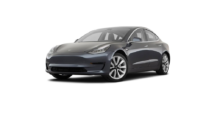Use Scheduled Departure to set a daily time when you want Model X to be ready to drive. Your vehicle automatically calculates when it needs to start preconditioning and/or charging. This ensures that charging is complete and/or the cabin climate and Battery are preconditioned by your departure time.
When Scheduled Departure is displayed, touch Schedule to set a daily time when you want Model X to be ready to drive. Specify a time, then touch Settings to enable one or both of the following departure features. When plugging in with Off-Peak Charging enabled, the vehicle briefly draws power (you may hear clicking) to calculate the necessary charging start time.
After you’ve specified your desired settings, touch Set. The touchscreen displays your scheduled departure time.
- Preconditioning warms the Battery for improved performance and ensures a comfortable cabin climate at your set departure time.
Note
When Model X is not plugged in, preconditioning operates but only when the Battery’s charge level is above 20%.
- Off-Peak Charging delays charging and automatically starts charging in order to finish before your scheduled departure time while also ensuring to charge the Battery during off-peak hours to reduce energy costs. Touch Change Off-Peak Hours to customize the time when off-peak utility rates end.
Note
Choosing Off-Peak Charging can reduce energy costs even in market regions where off-peak utility rates are not applicable. For example, if charging starts as soon as you plug in, charging may complete much sooner. This causes the Battery to cool down to ambient temperatures and requires energy to warm it back up by your departure time. Therefore, even if off-peak utility rates are not applicable to you, it is recommended that you set Off-Peak Hours to the same time as your departure time in order to reduce energy consumption. If there is not enough time to reach the charge limit, charging starts immediately in order to charge as much as possible. Once charging has started and there is not enough time to complete charging during off-peak hours, charging continues until the charge limit is reached.
You can limit Preconditioning and Off-Peak Charging to weekdays only.





